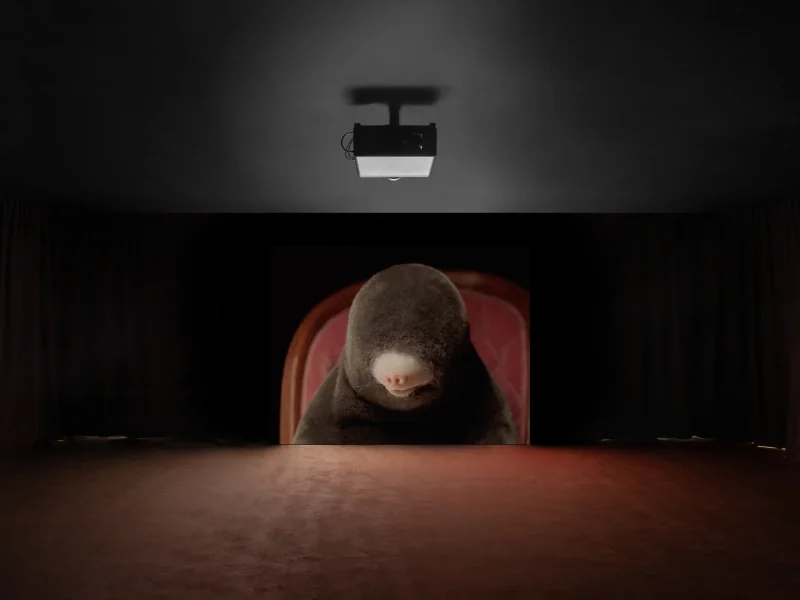Leaf 13
Expressive Code : Dot, Dash, Splash to Gibberish
[Frederick Hammersley, “A Good Line is Hard to Beat;” Will Rawls, Marilou Schultz, “Stab me Digital; “Diego Marcon, “Dolle;” Autumn Chacon, “Sound Waves;” Godrey Reggio, “Once Within A Time.”]
Code is fundamentally a machinic -generated short [getting shorter by the minute] pattern. Real-based codes are short numbers or letters or short-based translation tables used, for example, by banks, diplomatic letters, and now to unlock almost any human function that can then be translated into the “real thing.” Thought, itself, is considered to be a decipherable brain mosaic. Percepts, memories, recombinations, associations, scripts, schemas result, like polyphonic music, from the precise, complex compression, synchronization, and overlay of multiple mechanisms and cellular arrays in the cerebral and other cortices i
I still remember receiving, in the late 1970’s, a white punch card wondrously drawn with an outline heart and tiny holes spelling “I love you!” Frederick Hammersley’s witty computer drawings from 1969—made from the University of New Mexico’s then new mainframe computer—took me back to that historic Valentine’s Day.
This notably cool, abstract color painter interrupted his pictorial trajectory to become a designer of playful, punning images and Fortran-written statements accompanied by wry titles. A new type of concrete poetry resulted from now expressive symbols: jaunty periods, exciting slashes, hasty dashes, and a new evocative geometry of lively circles, zigzags, rectangles, squares. These warmer, suggestive elements later infiltrated his enlarged black and white and chromatic paintings—still hard-edged, but a trifle rollicking. Site Santa Fe mounts a delightful linear hang of multiplying sleeping pills, rolling waves, studded triumphal arch, a parade of marching ovals: all leaving the visitor with dimpled sight.
Choreographer, dancer, and writer Will Rawls abandons this rare comic mood to use broad washes of oil-based ink on large paper to capture improvisational or erroneous movements. His black and white smudged alphabet – looking somewhat like failed or missed targets--mutate across silk screens creating a cornice-spanning banner of misprints. Instead of computer-generated regularity, the artist sees current social codes as a series of dropped letters, missing strokes, blurred or overwritten smears.
Navajo artist Marilou Schultz creates contemporary tapestries that replicate computer circuit boards –with a difference--on a traditional wooden loom. Her hanging weavings enliven an otherwise shadowy gallery. These weighty woolen textiles, in vibrant organic and metallic-threaded hues, surreptitiously incorporate visual analogies to Dine animal mythology juxtaposed with splintery code. Spider Woman, for example, challenges stark chip geometry adding cultural complexity to the Digital Revolution. Importantly, her work is a powerful reminder [as a Site installation at the Santa Fe Military Museum also does] that Navajo code and Navajo-speaking coders were central to translating secret and deceptive enemy messages during World War II.
This theme of interpretation and misinterpretation culminates in Diego Marcon’s deeply disturbing cinematic sound piece in the adjoining gallery. Its guttural, indecipherable, and anxiety-producing noise, in fact, penetrates the Code gallery even though the unreeling feature remains unseen. Unlike other Site works that have been considered, this is an acoustic piece in which the sound is intrinsic or embedded within the visual. It is not a voice-over or polemical overlay.
So, like Mire Lee’s obscenely repumping sculpture of a clay vat filled with fecal- mud inflecting the viewer’s perception of the hidden erotics in the Red Gallery [that is, the object cannot be cognitively separated from the peristaltic slurping] nothing can distract our attention from Marcon’s mesmerizing speaking-screen. Shown by itself in a blacked-out room, the Italian cinematographer’s re-looping digital animation envelops the visitor in bewilderingly repetitive unthinking. No wonder this multisensory film leaves the exiting visitor in a state bordering on madness.
Two eyeless moles, seated in facing armchairs, read monotonously aloud in convincing gibberish from an apparently endlessly- scrolling digital printout. This unnerving nonsense is periodically punctuated by screams from their invisible children somewhere in the background but which leave their robotic parents immobile and unperturbed. Does this frozenness in unstoppable, senseless activity bring into focus our future life under ubiquitous AI, as well as our alarming distancing from reality? Godfrey Reggio’s 2022 film, Once Within a Time —whose title inspired this year’s Site Santa Fe --resonates with these uncomprehending code scanners. Hieronymus Bosch’s convulsive Tower of Babel becomes his film’s recurring leitmotif: the layered visual remains of an old myth protracted into our incoherent times.
i William H. Calvin, The Cerebral Cortex. Thinking a Thought in the Mosaic of the Mind [Cambridge, Mass. and London, MIT Press, 1996], pp. 42-43.

